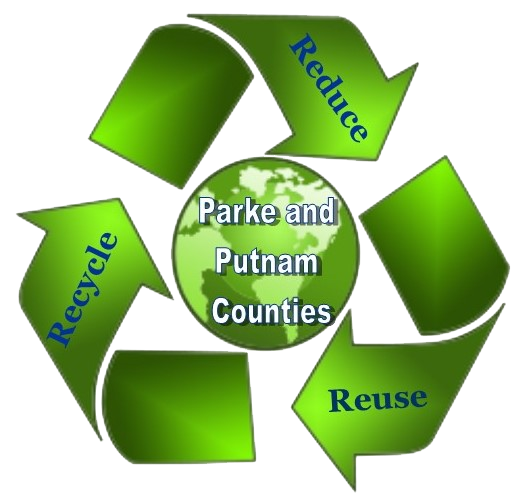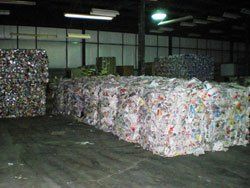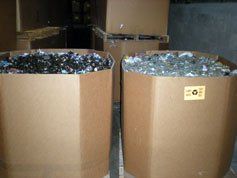Frequently Asked Questions
Why Recycle?
We have become a throw-away society. Nearly everything we use can be purchased in a disposable form. The result is a tremendous increase in trash, littering of our streets and public areas, illegal dumping, an increased dependence upon landfills for disposal and a tremendous depletion of our natural resources. Recycling reduces the demand on our natural resources, saves valuable landfill space, and creates opportunities for new industries. If we don’t reduce, reuse and recycle, we will eventually run out of space for all of our trash. What will we do with it then?
What can I Recycle?
The District has placed drop-off recycling centers in various rural communities throughout Parke and Putnam Counties and materials accepted there do not necessarily coincide with what that municipality collects. For more information on the Rural Recycling drop-off centers, go to the Programs Section of this website. If you live within the city limits of Greencastle, you can contact your street or public works department for more information regarding the specifics of their curbside recycling program.
What types of Plastics can be recycled at the District's rural recycling centers?
The District’s recycling centers now accept plastics #1-#7. This includes most food and beverage containers, prescription drug bottles, clear to-go food containers, yogurt cups and most other plastic containers with the #1, 2, 3, 4, 5, 6, or 7 in the chasing arrow recycling symbol on the bottom. This DOES NOT include thick, hard plastics like toys, yard ornaments, garden hose, cafeteria trays, baskets, plates, bowls, and utensils. These items contaminate the recycling and fill out the bins quickly which is frustrating to other residents and can become an eye sore for the host location when overflowing occurs. Always recycle responsibly. If you are unsure, please contact the District.
What is Household Hazardous Waste (HHW)?
HHW stands for Household Hazardous Waste and is defined as something in your home that could be dangerous that you no longer want. HHW is usually some type of chemical that may be toxic (poisonous), corrosive (can eat through skin or material), reactive (can cause a fire or a harmful gas to be produced if mixed with oxygen or another chemical) or an irritant (can cause soreness or swelling of your skin, eyes or internal organs). Examples include oil based paint, pesticides, antifreeze, bleach, etc. HHW should never be thrown in the trash, poured down the drain or into the ground because it can contaminate water sources and the environment. Instead, take materials to the District’s annual Tox-Away Days. For more information, check out Tox-Away Days under the Programs Section of this website.
Why doesn't the District offer more Tox-Away Days per year?
Tox-Away Days are very expensive. The District currently provides two separate events each year to Parke and Putnam Counties. The costs can exceed $40,000 for each event annually. We strongly encourage District residents from both counties to attend these annual events. For more information, go to the Programs Section of this website.
Where can I recycle E-Waste (electronic/electrical waste)?
It is important to recycle electronics as they contain heavy metals such as lead and cadmium that can be hazardous to health should they end up in our water stream or enter the environment in other forms. District residents can recycle their electronics at the annual E- Waste Day held in June at the Parke County Fairgrounds (Rockville) or at the annual Tox- Away Days “usually” held in May [Putnam County] and September [Parke County]. For more information, go to the Programs Section of this website.
Where's the dump (better referred to as a landfill)?
A landfill is a system of trash and garbage disposal in which the waste is buried between layers of earth to build up low-lying land. The District does not have a municipal landfill. When your trash is picked up, it is most likely taken to a transfer station, a site where trash is collected and reloaded into trucks for transport to a landfill [Republic Services, Greencastle, (765) 654-3902]. Often the District’s yard waste site are mistaken as “trash dumps”. However, these are facilities which accept yard waste (such as leaves, brush, limbs, and grass) to be composted. If you are in need of a public landfill, please contact one of the following locations: Twin Bridges in Danville, Indiana [317-745-2878] or Sycamore Ridge in Terre Haute, Indiana [812-299-9227].
In the past, trucks separated recyclables into categories such as glass, plastic, metal, and paper. Now they collect many of the recyclables and place them in one large bin - why?
This is called co-mingled (or single stream) collection, a process that is utilized across the country and deemed beneficial. Waste haulers or street departments are finding that if they streamline the collection process, the materials can easily be sorted at the material recovery facility (MRF); thus saving time and money while still turning out a good product.
Are Compact-Fluorescent Lights Dangerous?
Question:
I keep reading about how energy efficient compact-fluorescent light bulbs are, and I agree that saving energy is important. I’ve also heard that compact fluorescents contain mercury. Is this a bad trade?
Answer:
Senior editor Daniel S. Morrison replies: Compact-fluorescent lightbulbs (CFLs) use about 70% less energy than old-fashioned incandescent bulbs, and they can last 10 times longer. But that energy efficiency comes with a price: mercury.
Mercury has long been identified as highly toxic. In humans, it can harm the brain, heart, kidneys, lungs, and immune system. According to the Environmental Protection Agency (EPA), “High levels of methyl-mercury in the bloodstream of unborn babies and young children may harm the developing nervous system, making the child less able to think and learn.” Ironically, mercury is an ingredient in scores of consumer products, including cosmetics (eyeliner, mascara, and skin creams), children’s sneakers, thermostats, and fluorescent lights.
CFLs contain around 4 mg of mercury, a small amount compared to what can be found in fluorescent tubes, neon lights, and thermostats.
But is mercury content for energy efficiency a bad trade? Let’s look a little deeper. Mercury is a naturally occurring element that is found in many rocks. One of those rocks is coal. When coal is burned, mercury is released into the air. As it turns out, coal-fired electricity plants are the single-biggest source of airborne mercury in the United States (40%), followed by industrial boilers (10%), hazardous-waste burning (5%), and chlorine production (5%).
Mercury in the air eventually settles into water or onto land, where it can be washed into lakes and rivers. There, microorganisms convert it to methylmercury, the most-common form of mercury exposure in humans. Mercury concentration builds up in fish, shellfish, and animals that eat fish, including people.
Mercury in a CFL isn’t dangerous as long as the bulb doesn’t break. But burning coal always releases mercury, which ends up in the air, the soil, and the water. While we’d like there to be no mercury in a CFL, at least fluorescents have a comparatively tiny amount. I think it’s a good trade.
Unbroken CFLs should be recycled, which can be challenging in many places. Start by going to www.epa.gov/cfl for info. Broken bulbs should be cleaned up and thrown away. Click on the “read more” box below for instructions on how to properly clean up a broken fluorescent light.
Compact-fluorescent bulbs contain small amounts of mercury. About 4 mg of mercury is contained within a compact-fluorescent bulb. This amount is about the size of the tip of a ballpoint pen. Standard 4-ft. fluorescent tubes contain 10 times that much. Neon lights have 25 times as much, and a standard residential wall-mounted thermostat contains 750 times as much.
How to clean up a broken fluorescent light. If a fluorescent tube or compact-fluorescent bulb breaks in your home, don’t just reach for the vacuum cleaner. Instead, follow the EPA’s cleanup instructions:
If a fluorescent tube breaks on a hard surface:
- Open a window, and leave the room for 15 minutes or more.
- Scoop up the fragments and powder with stiff paper or cardboard, place them in a plastic bag, and seal it.
- Wearing disposable rubber gloves, wipe the area clean with damp paper towels, and place the paper towels and the gloves in a plastic bag.
- Put the first bag in a second plastic bag, seal it, and put it in an outdoor trash container.
- Wash your hands.
If a fluorescent tube breaks on a carpet:
- Remove as much glass and powder as you can with stiff paper or cardboard.
- Use the sticky side of duct tape to pick up the smaller pieces.
- Place the debris and the tape in two plastic bags, and seal them.
- When all the visible materials are removed, vacuum the area, remove the vacuum bag, and put the bag or vacuum-canister debris in two sealed plastic bags in the outdoor trash for disposal.



